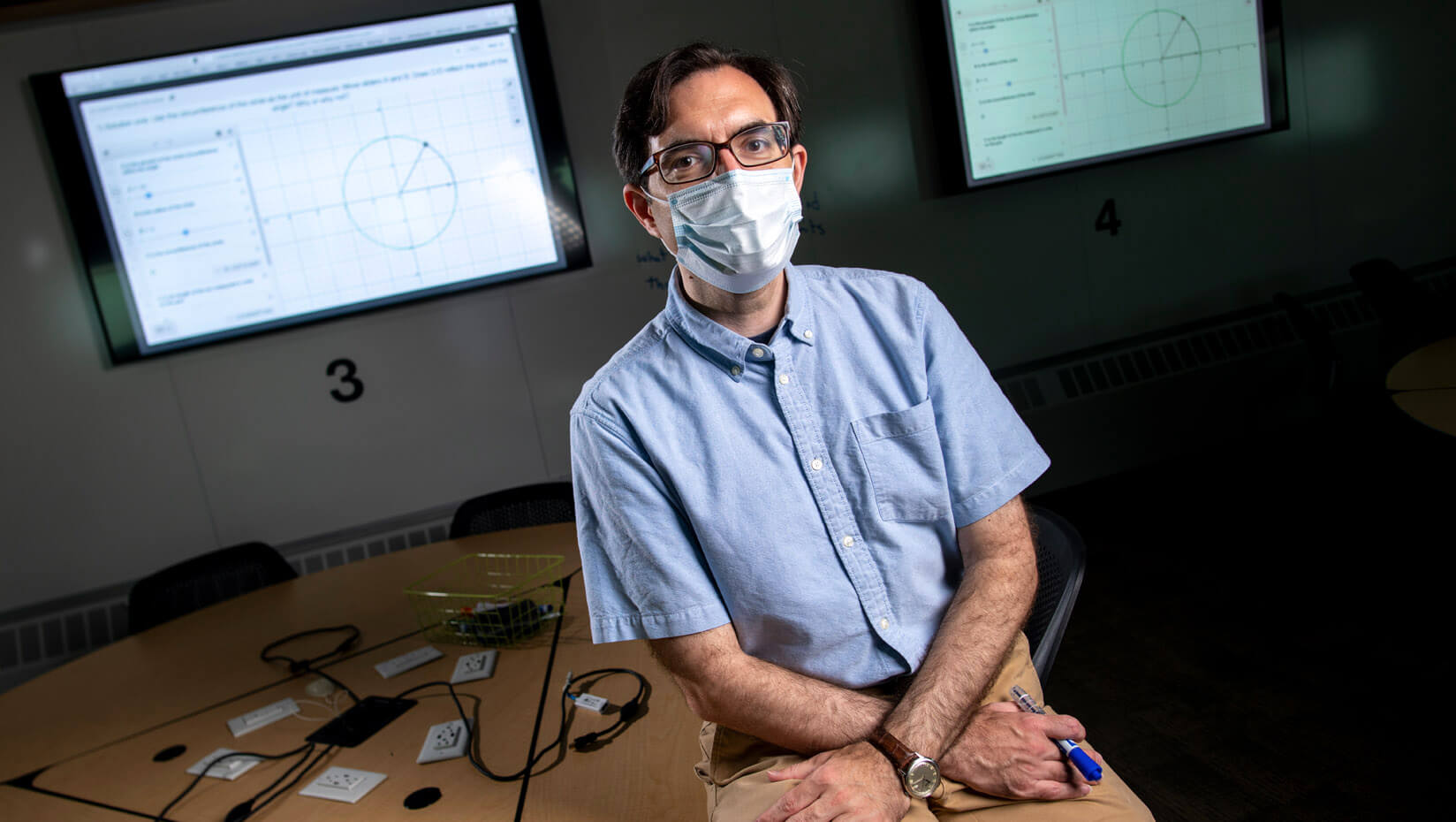
Boester devises methods to preserve collaborative, learner-focused mathematics instruction during pandemic
Students enrolled in Timothy Boester’s precalculus class learn and implement mathematical concepts through group work, even during a pandemic.
Boester, an assistant professor of mathematics education at the University of Maine, says eliciting responses from students through learner-focused instruction not only helps them grasp the material, but helps him monitor their progress. Collaborative assignments also help students learn to articulate their thought processes to others, a vital skill in the world of professional employment, Boester says.
For example, to ensure each student understood the difference between an angle and an angle’s measure at the beginning of the trigonometry unit, Boester asked them to define the term “angle” and discussed their responses with the class. The activity builds on students’ prior knowledge, highlighting where they may have inappropriately merged the two ideas. Incorrect answers, Boester says, can serve as teaching moments. By having students discuss the material, Boester says he learns how they think and can enable them to obtain a more thorough understanding of the concepts in precalculus.
“Learning needs to be an active process, thinking about what we learn and how we solve problems mathematically,” Boester says. “We try to take students’ conceptions and build off of those ideas to give them a more robust sense of what’s going on. This approach to instruction is well supported by research on mathematics teaching and learning.”
UMaine’s shift to remote-instruction in mid-March in response to COVID-19 challenged Boester’s ability to facilitate group work, but he devised a solution.
Boester typically hosts the introductory math class, MAT 122, with 50–60 students in a collaborative learning space in Estabrooke Hall, where group members sit together and use the whiteboards on the walls. In an effort to replicate a collaborative work environment remotely, Boester created breakout chat rooms for each group of students during Zoom calls with the entire class. Student groups would enter the separate Zoom chat rooms to tackle collaborative assignments, then rejoin the main call with everyone to share their results for discussion.
The UMaine educator typically visits each group while they work and provides guidance when needed. The switch to online instruction made supervising group work more difficult, but feasible all the same, he says.
“I needed to come up with ways that would be faithful to the learning objectives I wanted to fulfill before the pandemic using these new modes,” of teaching, Boester says. “Some of the groups continued to work very well that way.”
To maintain active, collaborative learning in his precalculus curriculum, Boester plans to use a primarily online, synchronous mode of learning with elements of in-person instruction for fall 2020.
The majority of students will participate in group assignments remotely over Zoom, but each group will have one or two classmates to represent their group in person in the classroom on a rotating basis. Those students will serve multiple roles for their group. They will collect the group’s ideas and showcase them in the classroom, either on the whiteboard walls or on the classroom television screens. They will be able to see the work of the other groups and can report back to their group what the class as a whole is thinking. They will also serve as the primary spokespersons for their group, in order to request assistance or to voice their group’s thinking to the class.
The UMaine assistant professor will be physically present in his chosen classroom to monitor and instruct students when needed. After completing their tasks, the student groups will come back together over Zoom to recap what they’ve learned.
Assigning groups, discussing the parameters and expectations of collaborative work, and tracking students’ progress may prove more difficult in a predominantly online form of instruction, but Boester says having some students representing their groups as they perform the work in person should help.
“They’re going to assist me in building the norms of group work,” he says.
In addition to teaching UMaine students, Boester plans to work with five Maine high schools to incorporate a learner-focused precalculus curriculum in their classes. Participants include Old Town, Searsport, Dirigo and Massabesic high schools and Mattanawcook Academy.
Boester says implementing this learner-focused form of instruction can be difficult, but it helps teachers monitor their students’ progress and reinforce the mathematical concepts they teach.
“Start thinking carefully about what students are thinking and create opportunities where you can collect evidence for what they are thinking,” Boester says. “There are opportunities for your students to be doing work so you can observe what they are doing and understand what they are seeing. This method has really helped me connect with my own students.”
Contact: Marcus Wolf, marcus.wolf@maine.edu
